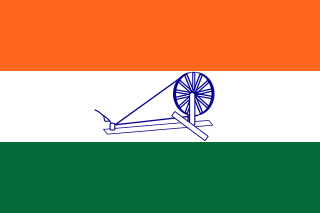
The Indian National Army was an armed force formed by Indian collaborationists and Imperial Japan on 1 September 1942 in Southeast Asia during World War II. Its aim was to secure Indian independence from British rule. It fought alongside Japanese soldiers in the latter's campaign in the Southeast Asian theatre of WWII. The army was first formed in 1942 under Rash Behari Bose, by Indian PoWs of the British-Indian Army captured by Japan in the Malayan campaign and at Singapore. This first INA collapsed and was disbanded in December that year after differences between the INA leadership and the Japanese military over its role in Japan's war in Asia. Rash Behari Bose handed over INA to Subhas Chandra Bose. It was revived under the leadership of Subhas Chandra Bose after his arrival in Southeast Asia in 1943. The army was declared to be the army of Bose's Arzi Hukumat-e-Azad Hind. Netaji Subhas Chandra Bose named the brigades/regiments of INA after Gandhi, Nehru, Maulana Azad, and himself. There was also an all-women regiment named after Rani of Jhanshi, Lakshmibai. Under Bose's leadership, the INA drew ex-prisoners and thousands of civilian volunteers from the Indian expatriate population in Malaya and Burma. This second INA fought along with the Imperial Japanese Army against the British and Commonwealth forces in the campaigns in Burma: at Imphal and Kohima, and later against the Allied retaking of Burma.

Gatka is a form of martial art associated primarily with the Sikhs of the Punjab and other related ethnic groups, such as Hindkowans. It is a style of stick-fighting, with wooden sticks intended to simulate swords. The Punjabi name, gatka, refers to the wooden stick used and this term might have originated as a diminutive of Sanskrit word, "gada", meaning mace.

Colonel Rajyavardhan Singh Rathore,, is an Indian politician, Olympic medallist, former shooting athlete and retired Indian Army officer. Rathore is a Member of Parliament in the 17th Lok Sabha from Jaipur Rural seat. He served as the Minister of State for Ministry of Youth Affairs and Sports in the Government of India till May 2019.

The Provisional Government of Free India or, more simply, Azad Hind, was an Indian Provisional government established in Japanese occupied Singapore during World War II. It was created in October 1943 and supported by – as well as largely dependent on – the Empire of Japan.

The Indian Military Academy (IMA) trains officers for the Indian Army. Located in Dehradun, Uttarakhand, it was established in 1932 following a recommendation by a military committee set up under the chairmanship of General Sir Philip Chetwode. From a class of 40 male cadets in 1932, IMA now has a sanctioned capacity of 1,650. Cadets undergo a training course varying between 3 and 16 months depending on entry criteria. On completion of the course at IMA cadets are permanently commissioned into the army as Lieutenants.
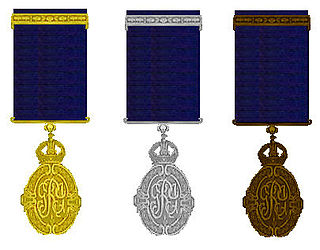
The Kaisar-i-Hind Medal for Public Service in India was a medal awarded by the Emperor/Empress of India between 1900 and 1947, to "any person without distinction of race, occupation, position, or sex ... who shall have distinguished himself by important and useful service in the advancement of the public interest in India."

Army Day is celebrated on 15 January every year in India, in recognition of Field Marshal Kodandera M. Cariappa's taking over as the first Commander-in-Chief of the Indian Army from General Fransis Bucher, the last British Commander-in-Chief of India, on 15 January 1949. The day is celebrated in the form of parades and other military shows in the national capital New Delhi as well as in all headquarters. On 15 January 2021, India celebrated its 73rd Indian Army Day in New Delhi. Army Day marks a day to salute the valiant soldiers who sacrificed their lives to protect the country and its citizens.
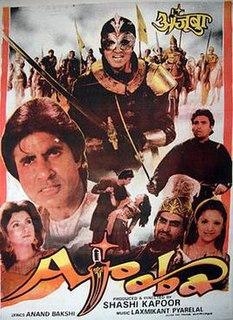
Ajooba (transl. Prodigy) is a 1991 superhero film, produced and directed by Shashi Kapoor and also co-directed by Soviet filmmaker Gennadi Vasilyev. An Indian-USSR co-production, it is loosely based on Arabic folklore. The film had a Russian language version released in the Soviet Union as two parts, Vozvrashcheniye Bagdadskogo Vora and Черный принц Аджуба.
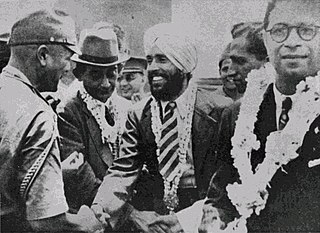
Mohan Singh was an Indian military officer and member of the Indian Independence Movement best known for organising and leading the Indian National Army in South East Asia during World War II. Following Indian independence, Mohan Singh later served in public life as a Member of Parliament in the Rajya Sabha of the Indian Parliament. He was a member of the Indian National Army (INA).

The Indian National Army trials was the British Indian trial by court-martial of a number of officers of the Indian National Army (INA) between November 1945 and May 1946, on various charges of treason, torture, murder and abetment to murder, during the Second World War. In total, approximately ten court-martials were held. The first of these was the joint court-martial of Colonel Prem Sahgal, Colonel Gurbaksh Singh Dhillon, and Major-General Shah Nawaz Khan. The three had been officers in the British Indian Army and were taken prisoner in Malaya, Singapore and Burma. They had, like a large number of other troops and officers of the British Indian Army, joined the Indian National Army and later fought in Burma alongside the Japanese military under the Azad Hind.
The Sardar-e-Jung was the second highest military decoration by the awarded by the Azad Hind Government. First instituted by Subhas Chandra Bose in Germany, it was later also awarded to troops of the Indian National Army in South East Asia. The award could be conferred with swords for valour in combat, and without swords for non-combat awards. At least three awards were made, one to Colonel Shaukat Ali Malik for the capture of Moirang, to Capt Shangara Singh Mann and to Lt Kunwar Balwant singh for capturing British Army Post at Modak. Capt. Mann was also awarded the Vir-e-Hind medal. Colonel Pritam Singh was awarded Sardar-e-jung, he captured a hill named Pritam Hill in Myanmar, Burma & Palel Airport.
The Vir-e-Hind was a military decoration awarded by the Azad Hind Government. The award was a second class star below the award of Sardar-e-Jung. First instituted by Subhas Chandra Bose in Germany, it was later also awarded to troops of the Indian National Army in South East Asia. The award could be conferred with swords for valour in combat, and without swords for non-combat awards. At least one award was made, to Capt Shangara Singh Mann. Capt. Mann was also awarded the Sardar-e-Jung medal.
The Shahid-e-Bharat was a military decoration awarded by the Azad Hind Government to honour the fallen. It was awarded in gold or in silver. First instituted by Subhas Chandra Bose in Germany, it was later also awarded to troops of the Indian National Army in South East Asia. The award could be conferred with swords for valour in combat, and without swords for non-combat awards.
The Tamgha-e-Bahaduro was a military decoration awarded by the Azad Hind Government. First instituted by Subhas Chandra Bose in Germany, it was later also awarded to troops of the Indian National Army in South East Asia. The award could be conferred with swords for valour in combat, and without swords for non-combat awards.
The INA Defence Committee, later the INA Defence and Relief Committee, was a committee established by the Indian National Congress in 1945 to defend those officers of the Indian National Army who were to be charged during the INA trials. Additional responsibilities of the committee also came to be the co-ordination of information on INA troops held captive, as well as arranging for relief for troops after the war. The committee declared the formation of the Congress' defence team for the INA and included famous lawyers of the time, including Bhulabhai Desai, Asaf Ali, Jawaharlal Nehru and as The British insisted that this was an Army Court Martial, Lt. Col Horilal Varma Bar at law and Prime minister of the state of Rampur was selected to head the defense Committee.
Ram Singh Thakuri 15 August 1914 – 15 April 2002) was an Indian freedom fighter, musician and composer. He composed a number of patriotic songs including Kadam Kadam Badaye Ja and Subh Sukh Chain whilst serving in the Indian National Army.

Major General Mohammed Zaman Kiani was an officer of the British Indian Army who later joined the Indian National Army, led by Subhas Chandra Bose, and commanded its 1st Division. He earned the Sword of Honour from the Indian Military Academy, and joined 14/1 Punjab Regiment.
The decorations of Azad Hind were instituted by Subhas Chandra Bose while in Nazi Germany, initially for the Indian Legion, to be awarded for gallantry in the field of battle. Both Indians and Germans were eligible for the decorations. Later, the same awards were instituted by the Azad Hind provisional government for the Indian National Army during its campaign in South-East Asia.
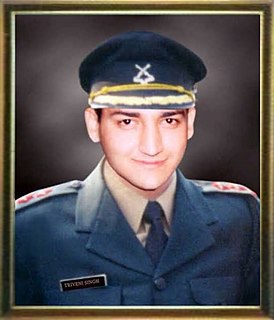
Lieutenant Triveni Singh was an Officer of the Indian Army from 5 Jammu and Kashmir Light Infantry and was posthumously awarded the Ashok Chakra Award, India's highest peacetime award, for his actions in the terrorist attack on Jammu Railway Station on January 2, 2004.
Shangara Singh Mann was an officer of the Indian National Army during World War II. He served as a captain and company commander during some of the earliest fighting against the British Indian Army in Assam, for which he was awarded the Sardar-e-Jung, the second-highest decoration bestowed by Azad Hind for valour in combat, and the Vir-e-Hind medal. Subhas Chandra Bose himself gave Singh Mann his medals in Rangoon. He was captured by the British and held in a prison in Multan from January 1945 to February 1946. Soon after he was released and he returned to his family in the Punjab, his life was disrupted by the partition of India. In 1959, he settled in Vadodara, Gujarat, where he remained as of 2001. He died at the age of 113.











